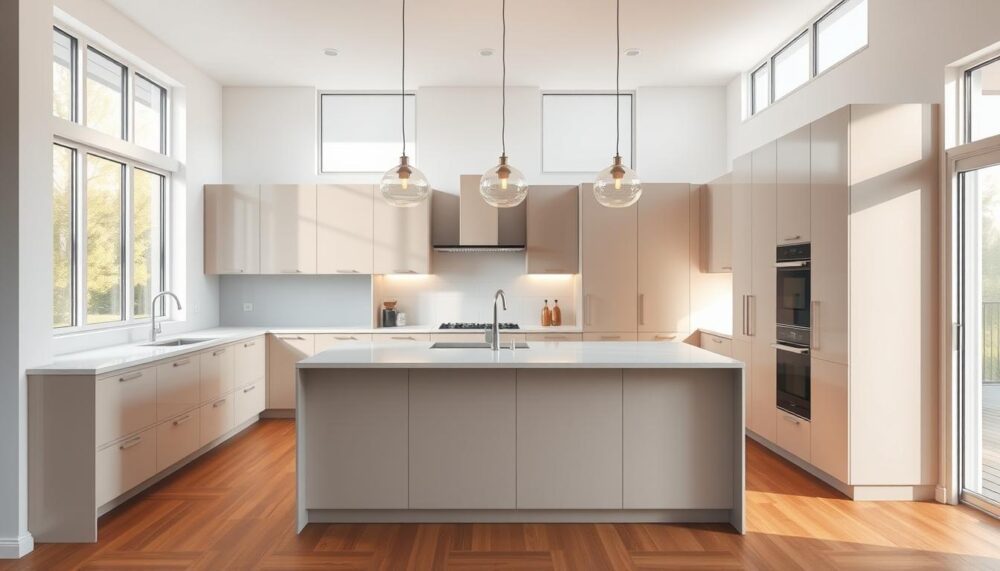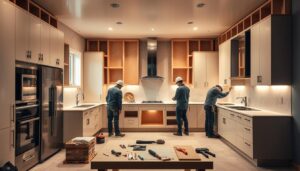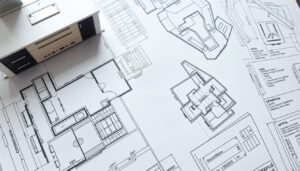Embarking on a kitchen renovation can be a daunting task, but with the right approach, it can also be incredibly rewarding. At AVO Renovations, we understand that professional project management is key to ensuring your new kitchen turns out exactly as you envision it. A well-planned renovation not only saves time but also helps you stay within budget and avoid costly mistakes.
One of the most common challenges homeowners face is unexpected expenses, with approximately 50% of renovation projects exceeding initial budget estimates1. However, with careful preparation and a solid plan, you can mitigate these risks. From the initial design phase to the final touches, each step requires attention to detail to ensure a seamless process.
In this guide, we will walk you through the essential steps of managing your kitchen renovation. You’ll learn how to set a realistic budget, choose the right materials, and coordinate with professionals to bring your vision to life. Whether you’re aiming for a modern look or a classic design, we’ve got you covered.
Introduction to a Successful Kitchen Renovation
Planning a kitchen renovation is an exciting journey, but it requires careful thought and preparation to ensure success. Every element, from design to functionality, must be considered to create a space that meets your needs and enhances your home’s value.
To achieve a successful renovation, it’s crucial to assess your needs and set clear priorities. Understanding how you use your kitchen—whether for cooking, dining, or socialising—will define the scope of your project. For instance, 55% of homeowners prioritise functionality over aesthetics2, ensuring their kitchen remains practical for daily use.
Careful planning is key to avoiding costly mistakes. Start by evaluating your current kitchen’s strengths and weaknesses. Consider factors like workflow, storage, and lighting. This foundational work will help you create a clear vision and set realistic goals for your renovation.
Remember, every successful project begins with a solid foundation. By taking the time to plan and prioritise, you’ll set yourself up for a smooth and rewarding renovation experience.
- Assess your kitchen’s current layout and usage patterns.
- Set clear priorities based on your needs and budget.
- Plan carefully to avoid unexpected issues during the renovation.
- Establish a solid foundation for your project with a clear vision.
With an average budget of £10,3002 for kitchen renovations in the UK, it’s essential to make sure every detail is well-considered to achieve the best results.
How to Project Manage a Kitchen Renovation
Effective project management is the backbone of any successful kitchen renovation. It involves overseeing every detail, from scheduling to coordination, ensuring everything runs smoothly. A good project manager must balance aesthetics with functionality, making sure the final result is both beautiful and practical.
Choosing the right materials is a critical part of the process. Quality worktops and cabinets can make or break the look and feel of your kitchen. Worktops, in particular, need to be durable and easy to maintain. Cabinets, on the other hand, should offer ample storage while complementing the overall design. According to recent data, the lead time for custom worktops can range from 2 to 6 weeks3, so planning ahead is essential.
Clear communication with tradespeople and suppliers is vital. Regular updates and prompt decision-making can help avoid delays. Sequential planning is key—start with structural work, then move on to finishes. This approach minimises disruptions and keeps the project on track.
Balancing aesthetic demands with functional requirements is equally important. While it’s tempting to focus on style, ensuring your kitchen remains practical is crucial. 70% of homeowners fail to plan for storage properly, leading to cluttered spaces3. Don’t make the same mistake—prioritise functionality without compromising on design.
Planning and Preparation: Setting the Foundation of Your Project
Planning and preparation are the cornerstones of a successful kitchen renovation. At AVO Renovations, we believe that a well-structured plan not only saves time but also helps you stay within budget and avoid costly mistakes. This phase is where your vision begins to take shape, ensuring that every detail aligns with your goals.
Assess Your Kitchen’s Needs and Priorities
Understanding your kitchen’s needs is the first step in any successful renovation. Consider how you use your kitchen—whether it’s for cooking, dining, or socialising. This will help you determine the must-have features versus the nice-to-have ones. For instance, 70% of homeowners prioritise functionality over aesthetics4, ensuring their kitchen remains practical for daily use. The “work triangle” concept, which optimises the distance between the fridge, sink, and hob, is essential for workflow efficiency5.
Establish a Realistic Budget
Creating a realistic budget is crucial for avoiding financial surprises. Allocate your resources wisely, with 30% for cabinets, 10% for countertops, and 14% for appliances6. Don’t forget to reserve 10-20% for unexpected expenses. For example, if your budget is £20,000, plan accordingly to cover all essentials without compromising on quality.
| Category | Percentage | Description |
|---|---|---|
| Kitchen Cabinets | 30% | Essential for storage and design |
| Kitchen Countertops | 10% | Durable and visually appealing |
| Kitchen Appliances | 14% | Energy-efficient and functional |
| Unexpected Expenses | 10-20% | Contingency fund |
By carefully assessing your needs and setting a realistic budget, you’ll set a solid foundation for a successful renovation. AVO Renovations’ expertise ensures that every detail is considered, helping you achieve your dream kitchen efficiently and cost-effectively.
Measuring Your Kitchen and Creating an Accurate Layout
Measuring your space accurately is the first step towards creating a functional and efficient kitchen layout. Without precise measurements, even the best designs can fail to deliver the desired results. Accurate measurements are essential for successful kitchen renovations, preventing costly errors later on7.
Taking Precise Measurements
Start by measuring the overall width and length of your kitchen, from one wall to the opposite wall. For irregularly shaped rooms, measure each section separately to ensure comprehensive data7. Don’t forget to note the placement of windows, doors, and utilities, as these elements significantly impact your layout. Record the distance from each corner to the edges of windows and doors, as well as their height from the floor. This level of detail ensures that your design accommodates all existing features.
Wall height should be measured at multiple points to check for consistency, as variations can impact cabinet installation7. Columns and protruding elements should be measured on all sides, paying special attention to any angled walls. Double-checking these measurements, especially those affecting cabinet placement and appliance fitting, is crucial to ensure consistency and accuracy7.
Sketching a Functional Kitchen Layout
Once you have your measurements, create a detailed sketch that serves as a blueprint for your layout. Consider the “work triangle” concept, which optimises the distance between the fridge, sink, and hob for workflow efficiency. This sketch should also maximise space utilisation, ensuring that your kitchen remains practical and functional. A well-designed layout contributes to the overall flow, making cooking and moving around the space more efficient.
When measuring for appliances, account for width, height, and depth, as well as additional clearance for ventilation or door opening7. Documenting the location of electrical outlets and plumbing is critical to avoid costly relocations during the renovation process7. Future-proofing your design by leaving space for additional appliances or outlets can enhance long-term functionality.
| Area | Measurement | Purpose |
|---|---|---|
| Walls | Width, height, and any irregularities | Ensures proper fit for cabinets and appliances |
| Windows and Doors | Placement, width, and height | Accommodates natural light and access points |
| Utilities | Location of plumbing and electrical outlets | Prevents costly relocations during renovation |
A well-designed kitchen should consider traffic flow, ensuring enough space for multiple users and ease of access to key areas like the stove, sink, and refrigerator7. By balancing precision with practicality, you can create a space that is both functional and aesthetically pleasing.
Securing Planning Permission and Necessary Permits
Understanding the legal requirements for your home improvement project is crucial to avoid any setbacks. Planning permission is often necessary for structural alterations, especially if your kitchen layout extends beyond certain limits. For instance, if your extension covers at least half the area around your home, you’ll likely need planning permission8.
When Permission is Required
It’s essential to consult your local planning authority early in the process. They can guide you on whether your project requires permission, especially for cases involving listed buildings or conservation areas. For example, extensions exceeding 50% of the original house area typically require planning permission8.
Aligning your kitchen layout and style with both regulations and personal taste ensures compliance without sacrificing design. Remember, securing all permits is vital to avoid project delays and potential legal issues.
- Structural changes often need planning permission.
- Consult local authorities early to avoid delays.
- Ensure your design meets both legal and aesthetic standards.
Ordering Essential Products for Your New Kitchen
When it comes to bringing your kitchen design to life, ordering the right products is a critical step. Timing and supplier reliability are key to ensuring your renovation stays on track and within budget.
Choosing Cabinets, Worktops, and Appliances
Selecting high-quality cabinets, worktops, and appliances is vital for both functionality and aesthetics. Cabinets should offer ample storage, while worktops need to be durable and easy to maintain. According to recent data, the lead time for custom worktops can range from 2 to 6 weeks9, so planning ahead is essential. Appliances should be energy-efficient and fit seamlessly into your layout.
Clear communication with suppliers is crucial to avoid delays. Regular updates and prompt decision-making can help keep your project on schedule. Sequential planning is key—start with structural work, then move on to finishes. This approach minimises disruptions and keeps the project on track.
Selecting Complementary Items and Materials
Complementary items like sinks and backsplashes can elevate your kitchen’s design. A well-chosen sink can enhance the functionality of your layout, while a backsplash adds both style and protection. Consider materials that are easy to clean and maintain, ensuring your kitchen remains practical for daily use.
“A beautiful kitchen is not just about looks; it’s about creating a space that works for you,” says AVO Renovations. “Take the time to source samples and inspect materials before committing. It’s a small step that can make a big difference in the final result.”
Managing delivery schedules is another important aspect. Synchronising deliveries with your renovation timeline ensures that everything arrives when needed, preventing delays. AVO Renovations recommends allowing a buffer period for unexpected delays, especially for custom orders.
- Plan ahead for custom worktops, which can take 2 to 6 weeks to deliver.
- Choose complementary items that enhance both form and function.
- Source samples and inspect materials before committing to an order.
- Coordinate delivery schedules to align with your renovation timeline.
By carefully selecting and ordering your products, you can ensure a smooth installation process and a beautiful, functional kitchen. Remember, the right materials and timely delivery are key to achieving your vision.
Establishing a Temporary Kitchen Setup
Setting up a temporary kitchen is essential during a renovation, as it helps maintain normalcy and functionality for daily meals. Without a temporary setup, families might end up eating out more frequently, which can be costly and less healthy10.
Optimising a Substitute Cooking Space
A well-organised temporary kitchen can significantly reduce stress during the renovation process. Start by identifying a spare room, such as a dining area or utility room, and equip it with basic appliances like a microwave, toaster oven, or electric kettle10. Ensure there’s access to a water supply, even if it’s just a bathroom sink, to handle dishwashing needs.
Lighting plays a crucial role in making your temporary kitchen functional. Use portable LED lights or additional lamps to brighten up the space, ensuring you can prepare meals safely and efficiently. Covering the floor with protective sheets can also prevent damage from spills or heavy appliances10.
Plan ahead by decluttering your kitchen before the renovation begins. Keep only essential items for meal preparation and consider using paper goods and plastic utensils to simplify cleanup10. Meal prepping is another effective strategy, allowing you to maintain healthy eating habits while your kitchen is under construction11.
Lastly, anticipate temporary inconveniences and plan accordingly. Whether it’s setting up a grill outdoors or using a rented storage pod for your belongings, flexibility is key to navigating the renovation smoothly1211.
Preparing for Demolition and Early Construction
Demolition is a critical phase that demands careful planning and execution. It’s essential to approach this stage with expertise to ensure safety and efficiency, drawing on industry best practices. Proper preparation and execution can prevent costly delays and potential hazards.
Safe and Efficient Demolition Practices
A thorough clean-out is the first step before commencing demolition. Remove all furniture, fixtures, and appliances to ensure a safe working environment. Safety tips include wearing protective gear like gloves, goggles, and masks to protect against dust and debris. According to recent data, the average kitchen demolition can take just a few hours13, but preparation is key to efficiency.
Managing Hidden Plumbing and Electrics
Unexpected issues like hidden plumbing and electrical wiring are common during demolition. These must be managed carefully to avoid disruptions. For example, if you discover hidden pipes, consult a professional to handle them safely. This ensures the structural integrity of your walls and prevents potential hazards. A well-planned approach can minimize disruptions and keep your project on track.
- Conduct a thorough clean-out before demolition begins.
- Wear appropriate safety gear to protect against dust and debris.
- Handle structural elements like walls with professional care.
- Address hidden plumbing and electrical issues promptly.
By following these steps, you can ensure a smooth transition into the construction phase. Proper planning and execution will set the stage for a successful renovation.
Managing Structural Alterations and Rough-In Works
Structural alterations are a cornerstone of any kitchen renovation, ensuring the space is both functional and safe. These changes often involve rerouting plumbing, electrical systems, and HVAC, which are critical for the room’s layout and usability. Proper planning during this phase is essential to avoid costly issues later.
Coordinating with Licensed Professionals
Engaging licensed professionals is vital for managing structural changes safely. Architects and tradespeople can handle complex tasks like rerouting utilities, ensuring compliance with building codes. According to recent data, scheduling MEP contractors separately optimizes project efficiency and prevents conflicts14.
Aligning rough-in works with your room’s layout ensures a stable base for future installations. For instance, the HVAC rough-in, including ductwork, is typically done before plumbing or electrical work to avoid interference14. This strategic approach ensures that tile work and final finishes are completed without issues.
Managing the rough-in phase effectively is crucial. Inspections after framing and MEP work are necessary to meet local building codes14. This step ensures that all structural changes are up to standard, providing a solid foundation for subsequent installations.
Installing Plasterboard, Paint, and Flooring
When transforming your space, the installation of plasterboard, paint, and flooring is crucial for achieving a polished look. This guide will walk you through selecting materials that blend durability with style, ensuring your kitchen stands the test of time.
Start by installing plasterboard to create smooth walls. Proper wall preparation is essential—fix cracks, sand, and prime for a flawless finish. According to experts, painting before installing cabinets can save time and reduce touch-ups, improving efficiency15.
For paint, choose durable options like eggshell or satin, ideal for kitchens prone to moisture. These finishes are easy to clean and maintain. Professional tips suggest using tape and plastic to protect fixtures during painting, ensuring they remain clean15.
Flooring selection should balance style and function. Options like hardwood or tile offer durability and aesthetic appeal. The average cost ranges from £3 to £10 per square foot, depending on the material16.
| Material | Durability | Maintenance |
|---|---|---|
| Plasterboard | High | Low |
| Eggshell Paint | Medium-High | Easy |
| Hardwood Flooring | High | Medium |
Uniform light and finish create a cohesive design. Plan your installation sequence to ensure a seamless look. For more insights, visit House & Garden for expert advice.
Fitting Cabinets, Worktops, and Appliances
Fitting cabinets, worktops, and appliances is a precise process that requires careful planning to ensure everything aligns perfectly. This step is crucial for achieving a polished final appearance and functionality in your kitchen.
Ensuring Accurate Measurements and Alignments
To ensure accurate measurements, start by using a laser measure to record precise dimensions of your space. Double-checking these measurements throughout the installation process is essential to avoid gaps and misalignments that could affect appliance installation17.
Strategies to avoid gaps include using shims and spacers to level cabinets and ensure a snug fit. For worktops, measure the space between cabinets and walls to ensure a seamless fit. This attention to detail prevents issues during appliance installation and enhances the overall look of your kitchen.
Every step in the process should be executed rigorously. For instance, install cabinets before worktops to ensure proper alignment. Practical tips include re-checking dimensions after each installation phase to catch any discrepancies early17.
A meticulous fitting phase leads to a polished final appearance. By following these steps, you ensure your kitchen is both functional and visually appealing.
| Component | Measurement Tips | Purpose |
|---|---|---|
| Cabinets | Measure height, width, and depth precisely | Ensure proper fit and alignment |
| Worktops | Measure the space between cabinets and walls | Prevent gaps and ensure a seamless fit |
| Appliances | Measure width, height, and depth | Ensure appliances fit perfectly into allocated spaces |
Adding Finishing Touches and Hardware Installation
The final stages of your kitchen transformation are where the magic happens. Finishing touches and hardware installation are what turn a functional space into a beautiful, personalised area that reflects your style.
Selecting Stylish Drawer and Cabinet Handles
Choosing the right hardware is crucial. It should complement your design style and stay within your budget. For instance, stylish handles can enhance the aesthetics of your cabinets, making a significant impact on the overall look. According to recent data, adding personal touches like handles can increase your home’s perceived value by up to 15%18.
When selecting handles, consider both form and function. Modern designs often feature sleek, minimalist handles, while traditional styles might opt for more ornate details. Brands like Häfele and Blum offer a wide range of options that merge style with durability, ensuring your handles remain functional and visually appealing for years to come.
Remember, the devil is in the details. Meticulous installation of these final elements is essential for completing the transformation. Even something as small as a handle can elevate the functionality and beauty of your kitchen area.
- Choose hardware that complements your design style and budget.
- Select handles that balance aesthetics with practicality.
- Consider brands known for durability and style.
- Ensure precise installation for a polished finish.
By paying attention to these small details, you can create a space that is both functional and visually stunning, ensuring your kitchen stands out as a true showpiece in your home.
Budgeting and Cost Considerations for Kitchen Projects
Budgeting is a cornerstone of any successful kitchen project, ensuring that your vision is realised without financial strain. At AVO Renovations, we understand that careful financial planning is essential for achieving your goals while staying within your means.
Tracking Expenses Effectively
Creating a detailed budget is the first step in managing your finances effectively. Allocate resources across various elements, such as cabinetry, worktops, and appliances, to ensure a balanced spend. For instance, cabinetry and hardware account for 35% of the typical kitchen project budget19, while installation costs make up 20%19. This structured approach helps in tracking expenses and making adjustments as needed.
Mixing Premium Materials with Budget Options
To achieve both style and affordability, consider mixing premium materials with more cost-effective options. For example, high-quality worktops can be paired with budget-friendly flooring to strike a balance. According to recent data, worktops constitute 10% of the renovation costs19, while flooring accounts for 7%19. This strategy allows you to prioritise key elements without overspending.
| Category | Percentage | Description |
|---|---|---|
| Kitchen Cabinets | 35% | Essential for storage and design |
| Installation | 20% | Covers labour and fitting costs |
| Appliances | 15% | Energy-efficient and functional |
| Worktops | 10% | Durable and visually appealing |
| Flooring | 7% | Style and functionality combined |
Planning cost-effective purchases ahead of time is another key strategy. AVO Renovations recommends setting aside 10-20% of your budget for unforeseen expenses20 to maintain financial flexibility. For more insights on budgeting, visit this resource for expert advice.
By carefully selecting materials and tracking expenses, you can achieve a beautiful and functional kitchen without exceeding your budget. Remember, the right plan and a bit of flexibility are key to staying on track financially.
Staying on Schedule: Time Management Tips
Effective time management is crucial for ensuring your kitchen renovation stays on track. Creating a detailed timeline can help prevent delays and keep the project moving smoothly21.
Creating a Realistic Renovation Timeline
A well-structured timeline is essential for any successful renovation. Allocate sufficient time for each stage, from demolition to finishing touches, and include buffer periods for unexpected issues. According to recent data, delays are often caused by unexpected problems, design changes, and material availability, making a realistic timeline even more important21.
- Build a detailed timeline for every stage of the renovation.
- Allocate 10-15% of the timeline for unexpected delays21.
- Use professional project management to coordinate tasks efficiently.
- Ensure each job is completed on time to avoid cascading delays.
- Adjust schedules as needed without derailing the project.
Professional project management can significantly reduce delays by up to 20-30% by coordinating multiple trades and tasks efficiently21. Regular communication and check-ins with contractors can also reduce delays by 15-20%21.
By following these tips, you can maintain a structured timeline and ensure your renovation progresses smoothly. Remember, effective time management is key to completing your project on schedule and within budget.
Seeking Professional Advice and Inspiration
Transforming your space into a dream kitchen can be a complex process, but seeking expert guidance can make all the difference. At AVO Renovations, we believe that professional advice is key to ensuring your renovation is both successful and stress-free.
Consulting with experienced professionals can simplify the entire renovation process, leading to better results and fewer complications. For instance, experts can offer valuable insights into each phase of your project, from initial planning to the final touches22. Their knowledge ensures that every detail, from plumbing adjustments to electrical work, is handled with precision and care23.

Visiting kitchen showrooms and design centres is another excellent way to gain inspiration. These spaces showcase a variety of materials and layouts, helping you visualise your ideal kitchen. Many showrooms also provide samples, allowing you to see and feel the quality of different worktops, cabinets, and appliances before making a decision24.
Learning from others’ experiences can also be incredibly beneficial. For example, attending events like the Homebuilding and Renovating Winter Virtual Show can provide access to expert advice and proven ideas24. Incorporating these insights into your plan can help you avoid common pitfalls and create a kitchen that truly meets your needs.
Ultimately, the key to a successful renovation is combining expert advice with your personal taste. By working with seasoned professionals and exploring design options, you can craft a kitchen that is both functional and beautiful. Remember, the right guidance can turn your vision into a reality.
Conclusion
Effective project management is the cornerstone of a successful kitchen renovation, ensuring your vision is realised with precision and care. By following the detailed guidelines outlined in this guide, you can navigate the process seamlessly, avoiding costly errors and delays. A well-managed project not only enhances functionality but also elevates the style of your space, creating a kitchen that truly reflects your lifestyle.
Key steps include meticulous planning, budgeting, and coordination with professionals. Allocating resources wisely, with 30% for cabinets and 10% for countertops, ensures a balanced spend25. Incorporating sustainable practices can reduce energy costs by up to 30% and increase home value by 5-10%26. Regular check-ins with contractors and using project management tools enhance organisation and tracking, keeping your project on schedule27.
With the right approach, a kitchen renovation becomes a rewarding experience. Use these insights as your guide to transform your space into a functional and beautiful area that stands the test of time. Turn your renovation challenge into a successful home improvement journey with AVO Renovations.
FAQ
How long does a typical kitchen renovation take?
A kitchen renovation can take anywhere from a few weeks to several months, depending on the scope of the work. Simple updates like replacing cabinets or worktops might take 2-4 weeks, while a full renovation could take 8-12 weeks or more.
What is the best way to plan a kitchen layout?
Start by assessing your space and needs. Consider the ‘triangle’ rule for your sink, hob, and fridge placement to ensure efficiency. Sketch your ideas and use software or consult a professional to refine your design.
How do I choose the right materials for my kitchen?
Select materials that balance durability, style, and budget. Popular choices include quartz for worktops, solid wood for cabinets, and ceramic tiles for flooring. Always consider maintenance requirements.
Can I handle the plumbing and electrical work myself?
It’s recommended to hire licensed professionals for plumbing and electrical tasks to ensure safety and compliance with local regulations. DIY attempts can lead to serious issues if not done correctly.
What are the key elements to include in my budget?
Your budget should cover cabinets, worktops, appliances, flooring, lighting, and labour costs. Don’t forget to include a contingency fund for unexpected expenses.
How do I prepare my home for demolition?
Clear the space completely, protect adjacent areas with dust sheets, and disconnect utilities. Ensure all plumbing and electrical systems are safely capped before work begins.
What are the most popular kitchen styles right now?
Modern farmhouse, minimalist, and Scandinavian styles are currently trending. These designs often feature clean lines, neutral colours, and functional layouts.
How can I save money on my kitchen renovation?
Consider refacing cabinets instead of replacing them, opt for mid-range appliances, and shop during sales. Mixing premium and budget materials can also help reduce costs.
What should I look for in a kitchen showroom?
Visit showrooms to see materials and designs in person. Pay attention to quality, finish, and functionality. Don’t hesitate to ask staff for advice and inspiration.
How do I create a functional kitchen layout?
Focus on workflow and accessibility. Ensure your sink, hob, and fridge are positioned to minimise movement. Incorporate ample storage and consider your personal cooking habits.
What lighting options are best for kitchens?
Use a combination of task, ambient, and accent lighting. LED options are energy-efficient and provide bright, even illumination for cooking and prep work.
How do I choose the right worktop for my kitchen?
Consider durability, maintenance, and aesthetic appeal. Granite and quartz are popular for their resilience, while wood offers a warm, natural look.
What are the key phases of a kitchen renovation?
The process typically includes planning, demolition, structural work, installation, and finishing touches. Each phase requires careful coordination to stay on track.
How can I stay organised during the renovation?
Keep a detailed timeline, track expenses, and maintain clear communication with your contractors. Regularly review progress to address any issues promptly.
What are the benefits of hiring a professional?
Professionals bring expertise, ensure compliance with regulations, and handle complex tasks like plumbing and electrical work. They can also provide valuable design and material recommendations.
How do I ensure my kitchen renovation is eco-friendly?
Choose sustainable materials, invest in energy-efficient appliances, and consider recycling or reusing existing elements. Opt for low-VOC paints and eco-friendly flooring options.
What are the most common mistakes to avoid?
Poor planning, unrealistic budgets, and skipping professional consultations are common pitfalls. Ensure you have a clear plan and seek expert advice to avoid costly mistakes.
Source Links
- What order to do what and when for a kitchen renovation | Reno
- Waverley’s Top Tips for a Successful Kitchen Remodeling Project – Waverley
- A Complete Guide to Project Managing Your Kitchen Renovation
- How to Plan Your Kitchen Renovation: A Timeline Guide
- Our ultimate guide to kitchen renovation
- How to plan, design and manage your kitchen renovation with ease
- How to Measure Your Kitchen for Renovation: Step-by-Step Guide – Ross’s Discount Home Centre
- When do you need planning permission for home renovations? – Renovation Plan
- How to Plan a Successful Kitchen Renovation Like a Pro – Make It Right®
- Surviving a Remodel With a Temporary Kitchen – Neil Kelly
- How To Set Up A Temporary Kitchen While Remodeling
- Set Up a Temporary Kitchen During a Remodel
- Kitchen Renovation – Countdown To Demolition
- Planning the Rough-in Phase on your Rehab Projects
- Do You Paint a Kitchen Before or After Installation? Best Practices
- In What Order Do You Remodel a Kitchen? | Frey Construction
- Kitchen Design & Installation Process Guide | PB Kitchens & Bathrooms
- Planning A Kitchen? The Ultimate Guide To Renovation & Installation | The Kitchen Store
- How to Successfully Plan Your New Kitchen Budget
- How to project manage a kitchen renovation – Fdkitchenrenovationsbrisbane.com.au
- How to Manage the Timeframe of Your Kitchen Remodel/ Renovation?
- From Concept to Completion: The Kitchen Renovation Timeline Explained
- Compete Project Management | Audus Kitchens
- Where to get expert advice and inspiration for your home renovation project
- Kitchen Renovation Project Management: A Step-by-Step Guide – AIreno
- Kitchen Project Management: Navigating the Path – Byle’s
- Mastering Renovation Project Management: A Step-by-Step Guide | DIY Home Comfort






